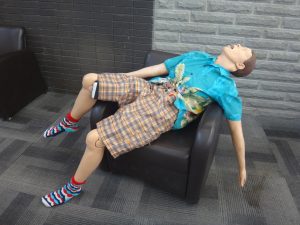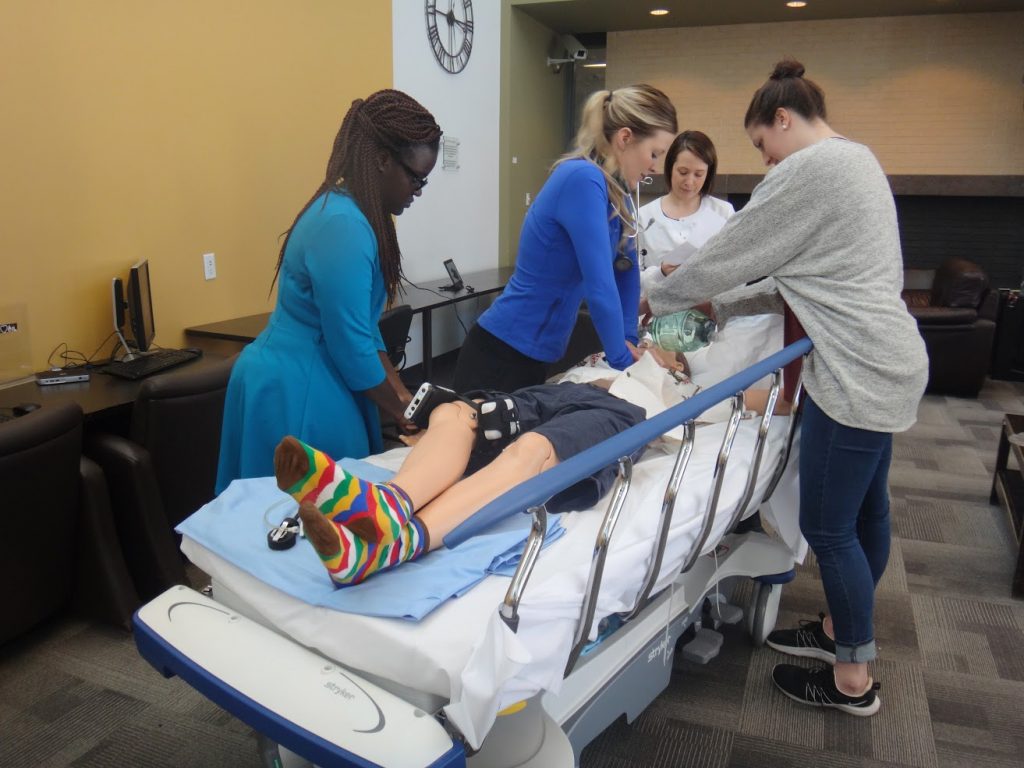Keyano College’s EMT and nursing students participated in an emergency simulation competition on Wednesday, April 12, 2017.
Nursing Instructor, Andrew Waddington brought the competition to Keyano so the students could build their team work and collaboration skills amongst the different health care disciplines.
“Part of the goal with this event was to get collaboration among students from different health professions, because that’s one of the things we are always struggling with in practice is collaborating with other team members,” said Waddington, “people often criticize that we all work in silo so one of the goals was to break those silos down and get students working together from different disciplines.”
Students from the Registered Nursing program, Licensed Practical nursing program and the EMT program made up 5 teams that participated in the competition.
The Students
Adriana Valdez is a third year nursing student at Keyano College.
She was born and raised in Fort McMurray and likes the small classes that Keyano offers.
She went into nursing because she wanted to help people and hopes to work in maternity with babies and mothers.
She took a leadership role alongside an EMT student in her group in attempts to learn more from a tactile teaching method.
“We never had very much experience with the simulation dummies, we got to work with them a little bit in labs but not in this kind of sense where they had them plugged in, doing a numerous amount of things,” said Valdez, “it is a great resource for our health care careers at Keyano.”
Brigit Shortt , another third year nursing student, also participated in the emergency simulation competition for the experience.
“I was really interested in the competition because I like the Emergency Acute Care setting, it’s the area of nursing that interests me the most,” said Shortt, “the way the program is laid out it doesn’t give us a lot of critical care practice and we get limited experience with the mannequins because they are expensive and in high demand.”
Waddington noted that a major reason why they were able to undertake this event was because of generous grant from BMO in the winter, which allowed them to upgrade their simulation equipment and bring their nursing and EMT labs up to date.
The Competition
The Faculty wanted to bring attention to the current rise of fentanyl crisis so they created a scenario around a young women who was at a party and had taken some kind of drug and overdosed.

Shortt recalls what it was like going through the simulation competition:
“Our patient who we found, was unresponsive at a party, had been smoking marijuana that had been laced with some form of opioid.
We knew it was fentanyl just because that’s the trending thing right now, but it really could have been any depressant.
The patient was found to be unresponsive with a depressed respiratory rate and pinpoint pupils so we gave her naloxone which you can’t really do any harm with, which is why it is promoted so hard in the community right now, it can’t make the situation any worse.
We gave the patient the naloxone and their vitals improved and they came to,” said Shortt.
The Outcome
Waddington and faculty wanted to see how the groups assessed the patient, what drug they elected to give the patient and how they went with the ongoing management and monitoring of the patient.
They had to work together as a team on how to best manage the patient.
“I think the importance [of the simulation competition] is so we could start collaborating with different disciplines while students are studying still, so they can start understanding each other scopes of practice and what each profession does well and what their expertise is so when they are working together in the real world they have a bit of a head start in terms of a multidisciplinary practice,” said Waddington.
Going into the simulation competition the students were unaware of what kind of scenario it was going to be but any nerves were quickly replaced by fun as it allowed them to really use their critical thinking skills in a practical settings and ultimately put their hard earned knowledge to the test.
“It was an amazing experience to learn the different knowledge that other health care professionals can offer to the group,” said Valdez, “it was very interesting to see how we could all collaborate together to save a simulation dummies life.”

Valdez says she can’t wait to do more simulations in the future and Shortt agrees.
She was able to get a much better understanding of the role of EMT’s.
“I did get the chance to see how the EMT’s in particular responded because it was an emergency responder situation and they have skills that are outside of our scope and they are able to do things that a basic RN is not able to do like intubate a patient,” said Shortt.
At the end the students reviewed as a group what challenges and strengths they had, how they worked together as a team and how the overall outcome of the patient was.
“The best outcome for me was just being able to know that I could apply my basic nursing skills to a critical situation,” said Shortt, “we’re always taught to start with our ABC’s (Airway Breath Circulation) and it was more intuitive than I expected.”
The competition was set up to provide the students a less stressful learning environment as there were no grades at stake.
It was more focused on team work and communication, not who did anything faster.
Waddington finds that if you take out of the evaluation and just make it a purely learning opportunity the students are able to get more out of it.
“It was a lot of fun, it was a good opportunity to practice an emergency situation in a controlled environment without any pressure of grades or impressing instructors,” said Shortt, “It was a calm, controlled environment so I found it extremely beneficial.”
A post survey of the participants on how the event went showed that 100% of them would participate in the event again and would recommend it to their peers.
“I’m very thankful for the instructors for putting it together for us and allowing us to have that experience to work with other members of Keyano, it was great working with the LPNs and EMTs as well so hopefully we will have more experience with them in the following years, “said Valdez, “It will be interesting to see in the future with more practice and experience what other roles I can take in situations like this.”







